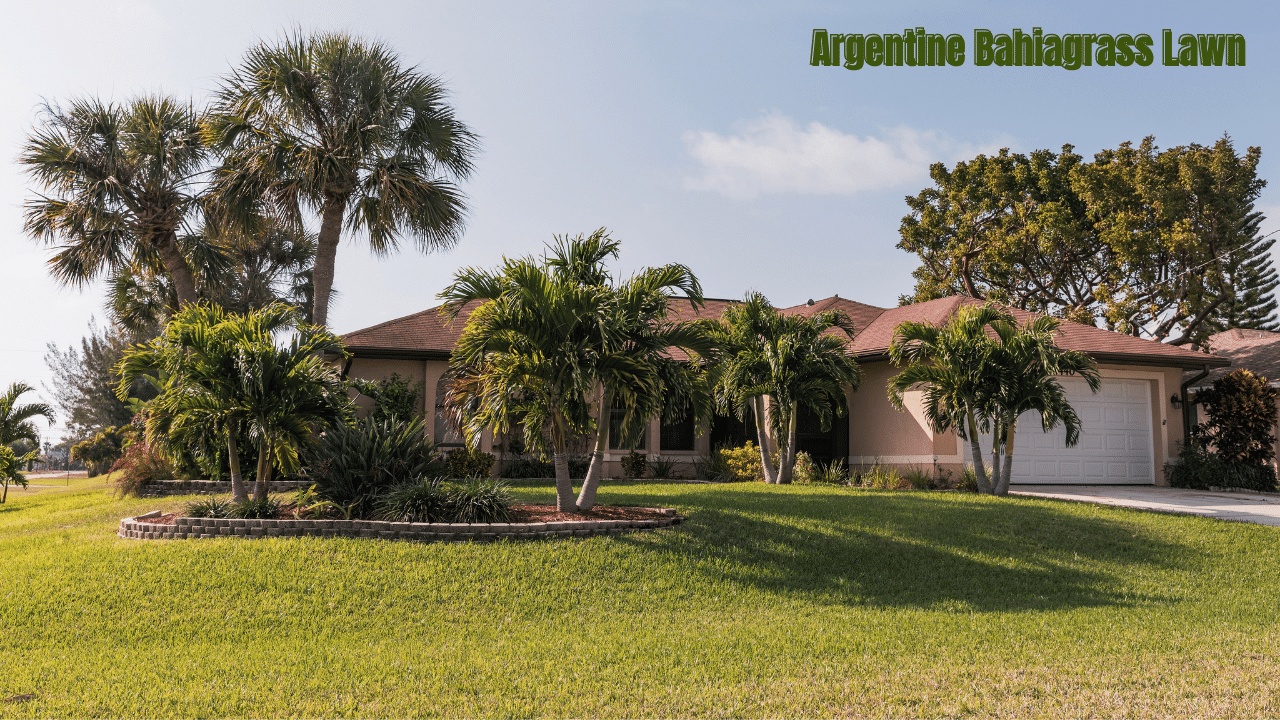Renowned for its high drought and heat tolerance, Bahiagrass is popular in southeastern lawns. This region is considered the most ideal for Bahiagrass varieties, giving homeowners a durable, low-maintenance turfgrass.

In particular, the Argentine Bahiagrass variety is ideal for Southern Coastal Plain and Gulf Coast lawns. It has a more delicate texture and darker color than its cousins, offering an attractive coastal yard.
Argentine Bahiagrass Seed
Here's a quick rundown of what to expect with Argentine Bahiagrass Seed.
The Argentine Bahiagrass is highly sun and drought tolerant, so it thrives in lawns with eight (or more) hours of sun exposure daily. Experts recommend planting this grass seed in the early spring so that you can see results within 7 to 21 days.
Ideal Application or Use |
|---|
Lawn, Pasture, Ground Cover, Cattle Forage, Livestock Grazing |
Average Germination Time |
|---|
21-30 days given optimal conditions |
Ideal Growing Locations |
|---|
Warm Season Zone (80º and 95º F) |
Average Height |
|---|
Lawn - 3 to 5 inches |
Sunlight Exposure |
|---|
8+ hours and total sun exposure to ensure the best results |
Recommended Planting Time |
|---|
Spring and Summer when nighttime temperatures are consistently more than 65 degrees (3 months before the first frost) |
Argentine Bahiagrass Characteristics
The Bahiagrass seed is known to germinate gradually but establishes itself well, so homeowners can reap the benefits of starting a lawn from seed. Since it has a naturally open growth nature, it can be susceptible to weeds in its growth and development stages. Its slow, steady growth is partly due to the stolons or short, above-ground stems. These roots at short intervals but form a dense, all-purpose turf once it matures.
Like Zoysia grass and other warm-season grasses, Argentine Bahiagrass takes on a consistent green color during its active growth period. During dormancy, the grass will take on a dark, tan color. It is suitable for extensive lawns with limited irrigation access and homeowners who prefer minimal lawn maintenance. (Related: 6 Best Types Of Florida Grass And Expert Maintenance Tips)
If you want to maintain a green lawn all year round, you may overseed the Bahiagrass in the autumn with cool-season ryegrass.
Planting Argentine Bahiagrass
Depending on your time and budget, you can choose to either plant seed or sod for your new Argentine Bahiagrass lawn (dark green). Start by loosening up the soil before spreading the Argentine Bahiagrass seed with a broadcast spreader. Ensure to follow the spreader setting on the product label. (Related: The 6 Best Grass Seeds to Consider for Sandy Soil)
Avoid putting too much seed, as this may only lead to weak seedlings. They may soon die if they cannot get the proper resources they need to develop and thrive.
Argentine Bahiagrass Care and Maintenance
This heat and drought-tolerant Bahiagrass variety fits harsh soil conditions, which may cause other grass types to die and shrivel up. Ideally, ensure that this turfgrass receives sufficient sunshine and high humidity on your lawn. This is an ideal climate for Argentine Bahiagrass.
To keep the Argentine Bahiagrass lush and lovely, avoid overwatering your lawn as this may only weaken the grass. When mowing, ensure that the blades are mowed to about two to three inches. Thicker blades may put a toll on poor-quality mowers.
Sometimes, choosing attractive yet durable lawn grass in the deep South or the Gulf areas can be difficult. Homeowners with sandy, acidic soil may also have difficulty selecting a luscious lawn grass seed… but you can start by considering Argentine Bahiagrass. It is a popular Bahiagrass variety with easy maintenance and care and thrives even in poor soil conditions.
Frequently Asked Questions (FAQs)
What is Bahiagrass?
Bahiagrass loves being under the sun and does not like to be in the cold or shade. It grows by stems that resemble roots or thick stolons. It doesn't spread quickly but grows into a thick carpet of grass. A Bahiagrass lawn is durable enough to withstand foot traffic but challenging to maintain (use a heavy-duty mower and regularly sharpen your blade). Compared to other warm-season grass, Bahiagrass does not tend to invade garden beds. Even better, it is tolerant of poor soil conditions and only requires less fertilizer.
How do I maintain a Bahiagrass lawn?
Starting in spring, Bahiagrass must be fed 2 to 4 times annually when it greens up through fall. If the soil has a pH higher than 7, feed it with iron products. Since the grass tends to create straggly seedheads, it will be best to mow it for about 2 -3 inches tall.
What are common Bahiagrass pests/diseases to be aware of?
Pests and diseases rarely affect Bahia grass. The mole cricket, which tunnels into the soil and damages roots, is the most significant pest threat. Except for dollar spot, which may leave areas all over the lawn many inches in diameter, very few diseases affect Bahiagrass lawns. When using commercial lawn products, carefully check the labels to ensure that they are not harmful to your Bahiagrass lawn.
What are the varieties of Bahiagrass?
Here are a few famous bahiagrass cultivars:
